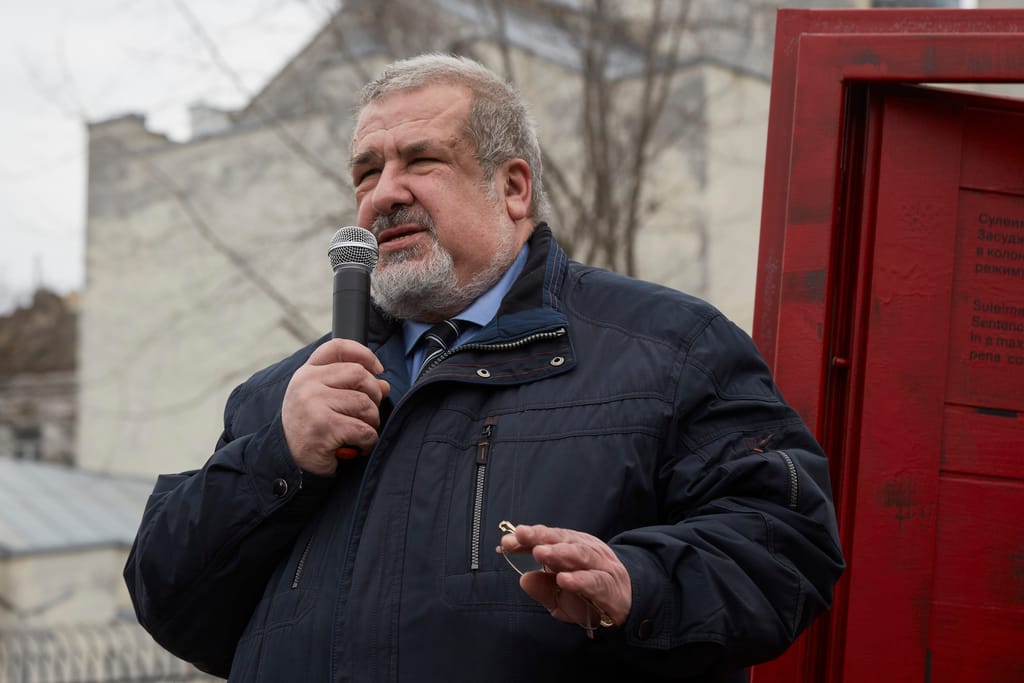KYIV — Alime’s phone was ringing non-stop after Russian President Vladimir Putin announced mobilization in Russia.
As a human rights activist in illegally occupied Crimea, she was overwhelmed by calls from September 21, coming from across the social spectrum. There were men nearly in their sixties; women; young medical workers; teachers; students; and people who had never done military service. They were mostly, like Alime, from the peninsula’s indigenous minority: the Crimean Tatars.
They all asked the same thing: How can people avoid being drafted into the Russian army to fight against Ukraine?
“I was literally advising people round the clock for the first two days, with just a little break to sleep,” said Alime, who asked to use a pseudonym because of her need to remain anonymous while working in Russian-occupied Crimea. “This call to the Russian army is seen as completely unacceptable to most Crimean Tatars.”
Since Russia’s so-called partial mobilization, announced after Russian forces suffered a heavy defeat in northeastern Ukraine, Ukrainian monitoring groups say several thousand draft notices have been distributed in Crimea, the Black Sea peninsula that Russia occupied and annexed from Ukraine in 2014. At least 1,500 draft notices have been handed out in settlements inhabited primarily by Crimean Tatars, a Turkic Muslim minority who opposed Russian annexation and make up about 13 percent of Crimea’s population of 2 million.
The new draftees will join thousands of Ukrainians who have already been called up to fight from Russian-occupied Donetsk and Luhansk in east Ukraine.
Ukrainian President Volodymyr Zelenskyy has called on all Ukrainians in occupied territories to dodge the draft or, if they do end up on the frontline, to save their lives and avoid fighting fellow Ukrainians by surrendering.
Indeed, Zelenskyy is making special reference to Putin’s recruitment of the Crimean Tatars and is warning of the genocidal specter looming over much of the mobilization, which in Russia has disproportionately affected ethnic minority areas such as Dagestan in the Caucasus, where poverty is high, protests struggle to make an impact and there are few jobs other than the army.
“This is a deliberate attempt by Russia to destroy the Crimean Tatar people, this is a deliberate attempt by the aggressor state to take the lives of as many residents of the territory the Russian troops invaded as possible,” Zelenskyy said on September 23.
Crossing the frontlines and escaping to free Ukrainian territories is not easy, however. At the same time, Ukraine has sentenced many whom it has taken prisoner for treason. Russia, meanwhile, has passed laws imposing lengthy prison terms for desertion and voluntary surrender. The calculus for drafted Crimeans and Ukrainians is complex, and steeped in dangers.
“There’s a choice now whether to run away, or refuse to serve, with all the consequences of that, or risk ending up on the field of battle and managing to surrender only to end up in a Ukrainian prison,” said Alyona Lunyova, advocacy director of ZMINA human rights center in Ukraine. “All the choices are bad.”
Getting rid of undesirables
According to Refat Chubarov, head of the Crimean Tatar governing body, the Mejlis, now based in exile in Kyiv, Russian mobilization in occupied territories such as Crimea is an international war crime.
His legal reasoning is solid. The fourth Geneva convention prohibits an occupying power from compelling occupied populations to serve in its armed forces. Since annexation, Russia has already conducted 15 illegal conscription campaigns and enlisted over 30,000 people in Crimea. According to the Ukrainian general staff, at least 139 Crimeans have been killed fighting for Russia in Ukraine since February, and 22 are currently prisoners of war.
If that were not enough, the ethnic targeting cuts deep. By sending Crimean Tatars to the frontline to potentially be killed, the mobilization looks like a deliberate attempt to wipe out a group that has long been a thorn in Moscow’s side, Ukrainian authorities have said.
“By resolving the issue of mobilization, the occupation authorities have also taken it on themselves to destroy as much as they can of the adult Crimean Tatar population,” said Chubarov. “It has signs of genocide.”
The Crimean Tatars have a long history of opposition to Russia, under whose rule they were gradually dispossessed until the entire population was deported from Crimea in 1944. They came back in the 1990s, throwing in their lot with Ukraine only to find themselves again living under de facto Russian rule after 2014.
Since opposing Russian annexation, about a hundred Crimean Tatars have been imprisoned on politicized charges of ‘extremism’ or ‘terrorism’; on September 21, Nariman Dzhelyal, one of the last representatives of the Mejlis still in Crimea, was sentenced to 17 years in prison. Since Russia’s full-scale invasion of Ukraine at the end of February, all freedoms in Crimea have been further restricted, notes a report by the U.N. human rights monitoring mission in Ukraine, with at least 89 individuals prosecuted for “discrediting the armed forces of the Russian Federation.”
Forced mobilization is aimed not just at Crimean Tatars but at ethnic Ukrainians too in Crimea and other occupied territories, by Russian leaders who have repeatedly questioned Ukrainians’ right to exist.
“Mobilization is a way of getting rid of undesirable people, it’s a kind of murder,” said Lunyova from ZMINA human rights center. “Once they get weapons and end up on the front, their chance of survival are almost zero.”
Mass exodus
As throughout Russia, mobilization in Crimea has been indiscriminate, following none of the exemptions laid down in official Russian statements, said Alime. Some of the people she advised were tricked into opening their doors at home, or got a phone call asking them to come to the local council about a different matter, and were then picked up right outside the council building. Of several people she knows who have already been taken to military training centers, one has health problems that should exempt him, while another has a disabled child.
“The draft papers are being given out in complete chaos,” she said.
Meanwhile, hundreds of thousands have fled Russia, and Crimea, to escape mobilization. Alime described roads crammed with traffic and shops and market stalls either closed or staffed now by elderly or female relatives of Crimean Tatar men.
“It’s a mass exodus. I think it’s even bigger than in 2014,” she said.
Telegram channels on how to flee Crimea are deluged with messages quoting prices from €400 to €1,000, or even more, for transport to Georgia, Kazakhstan or Belarus, comparing queues and experiences at border crossings, and discussing which documents are required.
With many countries still deciding whether to allow in the thousands of Russians now fleeing the draft, Ukrainians from Crimea with expired or only internal Ukrainian documents have been stranded on borders, especially with Georgia (the closest crossing to Crimea), said Chubarov. Chubarov wants neighboring countries to open a ‘green corridor,’ similar to that in European states bordering Ukraine in February and March, allowing Ukrainian citizens and citizens from occupied Crimea to escape.
But leaving Crimea could also be seen as enabling Russia to get rid of its undesirables. “I don’t tell anyone to leave or not, that’s their own choice,” Alime said. “I can only tell them the legal ways they can dodge the draft.”
Those hiding from or fleeing mobilization hope they can soon return to their homeland, once again under Ukrainian rule. “I know that of those who have left Crimea, almost all left their families here, because they plan to come back as soon as possible,” Alime said.
Belligerents, or victims?
Ukrainian authorities, from President Zelenskyy downwards, have publicly encouraged those who cannot avoid being drafted to lay down their arms and surrender at the first opportunity once they are sent to Ukraine, and have issued instructions on how to do so.
In reality, however, this is extremely difficult to do. Over 50 Ukrainians from Russian-occupied Donetsk and Luhansk who were taken prisoner by Ukraine while fighting on the Russian side since March have been tried for treason. Despite extensive evidence of forced mobilization, including men being kidnapped off the streets, or rounded up in their workplaces, courts are handing down sentences of up to 15 years, says Lunyova. With the Russian mobilization in Crimea and ‘referendums’ in occupied south Ukraine, ever more Ukrainians may be similarly sentenced.
“The number of people who can potentially end up at the front against their will is going to increase catastrophically,” said Lunyova. “When we tell them to surrender, we should be honest and tell them they will very likely come under criminal investigation.”
Tamila Tasheva, Ukraine’s presidential representative for Crimea, said each individual should prove in court that they were forcibly mobilized and did not commit any war crimes. “You have to understand that if you shot at a Ukrainian soldier then you’ll be treated as an enemy. Our advice to surrender is not a way to avoid responsibility. But if you were forced to go to war that will be taken into account,” she said.
Despite public condemnation of Russia’s forced mobilization, the discovery of war crimes on territories liberated from Russian occupation has focused Ukrainian public discourse on collaboration, making it difficult to question the treatment of those who fought, however unwillingly, for occupation forces, says Lunyova.
The subject is vital for the future of Ukraine.
“We have to talk about these uncomfortable topics because in the end, after this war, we will have to reintegrate and bring our country back together again,” she said. “Opportunities for resocialization of [those sentenced as] traitors and collaborators is not very high. We have to make sure those who did not want to fight and wanted to survive are treated differently than those who volunteered to fight. We should treat them as victims.”




